--管理学罗宾斯9版英文
管理学,罗宾斯,9版,英文Robbins_fom9_09
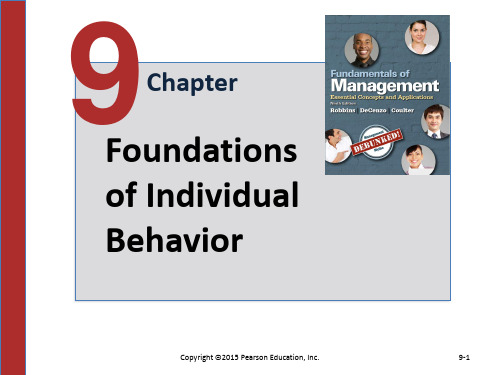
• Describe different personalight © 2015 Pearson Education, Inc.
9-2
Learning Outcomes (cont.)
9Chapter Foundations of Individual Behavior
Copyright © 2015 Pearson Education, Inc.
9-1
Learning Outcomes
• Identify the focus and goals of organizational behavior (OB).
Copyright © 2015 Pearson Education, Inc.
9-13
Emotional Intelligence
Five dimensions: • Self-awareness • Self-management • Self-motivation • Empathy • Social skills
9-11
Personality Theories
Personality: A unique combination of emotional, thought, and behavioral patterns that affect how a person reacts to situations and interacts with others.
Copyright © 2015 Pearson Education, Inc.
9-6
9.2 Explain the role that attitudes play in job performance.
管理学,罗宾斯,9版,英文Robbinsfom906
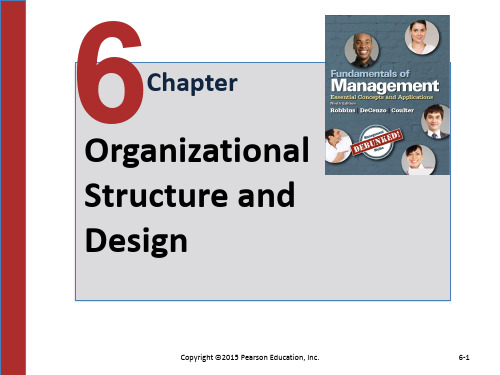
Copyright © 2015 Pearson Education, Inc.
6-2
6.1 Describe six key elements in organizational design.
Copyright © 2015 Pearson Education, Inc.
6-18
Size and Structure
Organic
Less than 2,000 employees can be organic.
Mechanistic
More than 2,000 employees makes forces organizations to become more mechanistic.
Copyright © 2015 Pearson Education, Inc.
6-10
Power Versus Authority
Copyright © 2015 Pearson Education, Inc.
6-11
Sources of Power
Copyright © 2015 Pearson Education, Inc.
6-27
Matrix and Project Structures
Copyright © 2015 Pearson Education, Inc.
6-28
Project Structure
A structure in which employees continuously work on projects.
6-26
管理学-罗宾斯-9版-英文Robbinsfom901
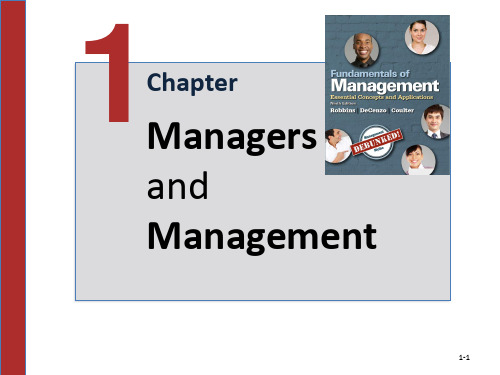
Copyright ©2019 Pearson Education, Inc.
1-9
What Is Management?
The process of getting things done effectively and efficiently, with and through people.
Copyright ©2019 Pearson Education, Inc.
1-18
Management Roles Approach
Copyright ©2019 Pearson Education, Inc.
1-19
Which Approach Takes the Prize?
Functions ☑
1. Four Functions Approach 2. Management Roles Approach 3. Skills and Competencies
Copyright ©2019 Pearson Education, Inc.
1-17
Four Functions Approach
•Planning •Organizing •Leading •Controlling
Copyright ©2019 Pearson Education, Inc.
1-31
1-32
Integrating economic, environmental, and social opportunities into business strategies
Copyright ©2019 Pearson Education, Inc.
1-30
Managers Matter!
Employee productivity, loyalty, and engagement hinge on employee\manager relationship
管理学,罗宾斯,9版,英文Robbinsfom913-精品文档31页

Copyright © 2015 Pearson Education, Inc.
1-6
Communication Channels
• Formal channels • Informal channels
Copyright © 2015 Pearson Education, Inc.
1-7
Decoding and Feedback
13 Chapter
Managing Communication and Information
Copyright © 2015 Pearson Education, Incribe what managers need to know about communicating effectively.
1-23
Personal Interaction
Social media can minimize personal interaction.
Copyright © 2015 Pearson Education, Inc.
1-24
Knowledge Management
Cultivating a learning culture in which organizational members systematically gather knowledge and share it with others.
1-22
Legal and Security Issues
• Electronic information is potentially admissible in court
• Sensitive, proprietary information at risk
管理学,罗宾斯,9版,英文Robbins_fom9_15b
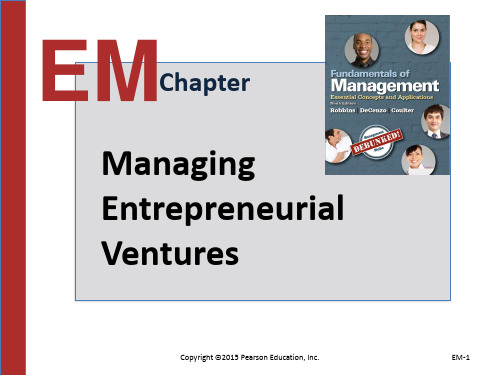
Managing Entrepreneurial Ventures
Copyright © 2015 Pearson Education, Inc.
EM-1
What is Entrepreneurship?
Entrepreneurship:
The process of starting new businesses, generally in response to opportunities.
Copyright © 2015 Pearson Education, Inc.
EM-3
Business Plans
• Executive summary • Synopsis business plan • Summary business plan • Fully business plan • Operational business plan
Copyright © 2015 Pearson Education, Inc.
EM-4
Components of a Full Business Plan
• Executive summary • Analysis of opportunity • Analysis of the context • Description of the business • Financial data and projections • Supporting documentation
Copyright © 2015 Pearson Education, Inc.
EM-5
Legal Forms of Organization
1. Sole proprietorship 2. General partnership 3. Limited liability partnership (LLP) 4. C corporation 5. S corporation 6. Limited liability company (LLC)
管理学,罗宾斯,9版,英文Robbinsfom903共33页文档

Copyright © 2015 Pearson Education, Inc.
1-12
Society’s Expectations
Copyright © 2015 Pearson Education, Inc.
1-13
Social Responsibility
• Corporate social responsibility (CSR) • Social obligations • Social responsiveness
• Describe how the workforce is changing and its impact on the way organizations are managed.
Copyright © 2015 Pearson Education, Inc.
1-2
3.1 Explain globalization and its impact on organizations.
Copyright © 2015 Pearson Education, Inc.
1-3
Globalization and its Impact
Global village a boundaryless world where goods and services are produced and marketed worldwide.
• Positive? • Negative? • Neutral?
ቤተ መጻሕፍቲ ባይዱ
Copyright © 2015 Pearson Education, Inc.
1-16
Sustainability Means Different Things to Different People
管理学,罗宾斯,9版,英文Robbins_fom9_ppt(2)

9-11
Personality Theories
Personality: A unique combination of emotional, thought, and behavioral patterns that affect how a person reacts to situations and interacts with others.
Copyright © 2015 Pearson Education, Inc.
9-22
Perceptual Shortcuts
Copyright © 2015 Pearson Education, Inc.
9-23
Understanding Perception
1. Employees react to perception, not reality. 2. The potential for perceptual distortion exists.
Copyright © 2015 Pearson Education, Inc.
9-6
9.2 Explain the role that attitudes play in job performance.
Copyright © 2015 Pearson Education, Inc.
9-7
Attitudes and Job Performance
9-15
Matching Personalities and Jobs
Copyright © 2015 Pearson Education, Inc.
9-16
Personality Traits Across Cultures
National cultures differ in terms of the degree to which people believe they control their environment.
罗宾斯管理学英文第9版

管理学第一章管理与组织学习导览一、管理者是谁?It used to be sim ply defined that they were the organizational m em bers who told others what to do and how to do it, but it is not quite that sim ple anym ore. A m anager is som eone who coordinates or oversees the work of other people so that organizational goals can be accom plished. A m anager’s job is not about personal achievem ent, but about helping others do their work. That m ay m ean coordinating the work of a departm ental group, or supervising a single person. It could involve coordinating the work of a team com posed of people from several different departm ents or even people outside the organization, such as tem porary em ployees or em ployees who work for the organization’s suppliers. And m anagers m ay have other work duties not related to coordinating the work of others.解释管理者与非管理的雇员有什么不同?Nonm anagerial em ployees are those organizational m em bers who work directly on a job or task and have no one reporting to them.组织中的管理者如何分类?In traditionally structured organizations—whi ch are usually said to be shaped like a pyram id because there are m ore em ployees at lower organizational levels than at upper organizational levels, m anagers are often described as first-line, m iddle, or top, and m ay have various titles.(1) First-line m anages, the lowest level of m anagem ent, m anage the work of nonm anagerial em ployees who are typically involved with producing the organization’s products or serving the organization’s custom ers. They often have the title of supervisor, and are called shift m anagers, district m anagers, departm ent m anagers, offi ce m anagers, or even foreperson.(2) Middle m anagers include all levels of m anagem ent between the first level and the top level of the organization. These m anagers m anage the work of first-line m anagers and m ay have titles such as regional m anagers, project leader, plant m anager, or division m anager.(3) Top m anagers: m anagers at or near the upper levels of the organizational structure who are responsible for m aking organization-wide deci sions and establishing plans and goals that effect the entire organization. These individuals typically have ti tles such as executive vice-president, president, chief operating officer, chief executive offi cer, or chairperson.二、管理是什么?Managem ent involves coordinating and overseeing the work activities of others so that their activities can be com pleted efficiently and effecti vely.解释为什么对管理来说效率和效力是重要的。
管理学,罗宾斯,9版,英文Robbinsfom909-精品文档35页

1-11
Personality Theories
Personality: A unique combination of emotional, thought, and behavioral patterns that affect how a person reacts to situations and interacts with others.
Copyright © 2015 Pearson Education, Inc.
1-14
Personality Traits
Can personality traits predict practical workrelated behaviors?
Copyright © 2015 Pearson Education, Inc.
Organizational Behavior
Copyright © 2015 Pearson Education, Inc.
1-5
Goals of Organizational Behavior
1. Employee productivity 2. Absenteeism 3. Turnover 4. Organizational citizenship behavior 5. Job satisfaction 6. Workplace misbehavior
Copyright © 2015 Pearson Education, Inc.
1-18
9.4
Describe perception and the factors that influence it.
Copyright © 2015 Pearson Education, Inc.
管理学,罗宾斯,9版,英文Robbinsfom908-精品文档31页
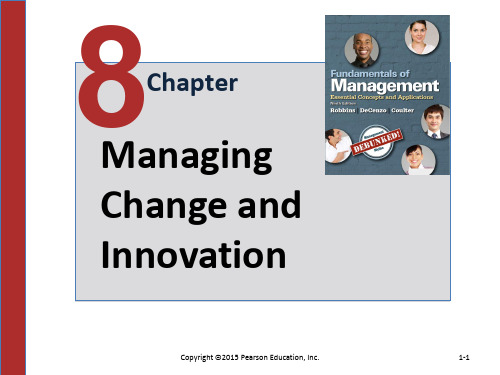
personal loss 4. Belief change is not
in organization’s best interests
Copyright © 2015 Pearson Education, Inc.
1-14
Copyright © 2015 Pearson Education, Inc.
8-5
Internal Factors
• Strategy • Composition of workforce • Employee attitudes
Copyright © 2015 Pearson Education, Inc.
8-24
Innovation Process
1. Perception 2. Incubation 3. Inspiration 4. Innovation
Copyright © 2015 Pearson Education, Inc.
8-25
Encouraging Innovation
Copyright © 2015 Pearson Education, Inc.
Copyright © 2015 Pearson Education, Inc.
8-8
Calm Waters Change
Copyright © 2015 Pearson Education, Inc.
8-9
White-Water Rapids Change
Leading a company in change, in an industry in change.
8-26
Structural Variables and Innovation
管理学,罗宾斯,9版,英文Robbinsfom915
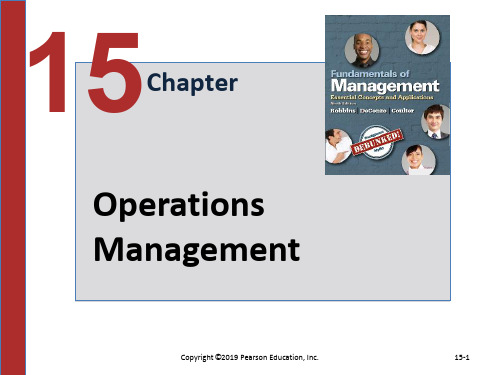
15-17
Employees and Human Resources
• Flexible job design • Effective hiring process • Ongoing training
Copyright ©2019 Pearson Education, Inc.
15-18
Obstacles to Value Chain Management
15-28
PERT Network Analysis
Copyright ©2019 Pearson Education, Inc.
15-29
PERT in Action
Copyright ©2019 Pearson Education, Inc.
15-30
PERT in Action (cont.)
15-15
Successful Value Chain Management
Copyright ©2019 Pearson Education, Inc.
15-16
Organizational Processes and Leadership
1. Better demand forecasting 2. Select functions done collaboratively with other
Copyright ©2019 Pearson Education, Inc.
15-31
15-32
Copyright ©2019 Pearson Education, Inc.
15-7
Operations Management and Company Strategy
Successful organizations recognize the crucial role that operations management plays as part of the overall organizational strategy to achieve and maintain global leadership.
管理学,罗宾斯,9版,英文Robbinsfom913
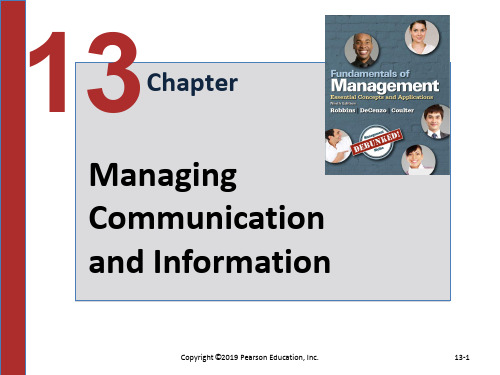
13-22
Legal and Security Issues
• Electronic information is potentially admissible in court
• Sensitive, proprietary information at risk
Copyright ©2019 Pearson Education, Inc.
Copyright ©2019 Pearson Education, Inc.
13-16
Networked Communication Applications
•E-mail •Instant messaging (IM) •Voice-mail •Fax machines
Copyright ©2019 Pearson Education, Inc.
managers need to know about communicating effectively.
Copyright ©2019 Pearson Education, Inc.
13-3
Effective Communication
Communication:
A transfer of understanding and meaning from one person to another.
Copyright ©2019 Pearson Education, Inc.
13-29
13-30
• Explain how technology affects managerial communication.
• Discuss contemporary issues in communication.
- 1、下载文档前请自行甄别文档内容的完整性,平台不提供额外的编辑、内容补充、找答案等附加服务。
- 2、"仅部分预览"的文档,不可在线预览部分如存在完整性等问题,可反馈申请退款(可完整预览的文档不适用该条件!)。
- 3、如文档侵犯您的权益,请联系客服反馈,我们会尽快为您处理(人工客服工作时间:9:00-18:30)。
Decentralization
lower-level managers provide input or actually make decisions
Copyright © 2015 Pearson Education, Inc.
6-6
Types of Authority Relationships
Copyright © 2015 Pearson Education, Inc.
6-7
Line and Staff Authority
Copyright © 2015 Pearson Education, Inc.
6-8
Unity of Command
6-16
Models of Organizational Design
Copyright © 2015 Pearson Education, Inc.
6-17
Strategy and Structure
6-12
Span of Control
Most effective and efficient span depends on: • Employee experience and training (more they
have, larger span). • Similarity of employee tasks (more similarity,
Copyright © 2015 Pearson Education, Inc.
6-10
Power Versus Authority
Copyright © 2015 Pearson Education, Inc.
6-11
Sources of Power
Copyright © 2015 Pearson Education, Inc.
Copyright © 2015 Pearson Education, Inc.
6-4
Specialization
Copyright © 2015 Pearson Education, Inc.
6-5
Departmentalization
Copyright © 2015 Pearson Education, Inc.
a right whose legitimacy is based on an authority figure’s position in the organization; it goes with the job
Power:
an individual’s ability to influence decisions
A structure in which each employee reports to only one manager.
Copyright © 2015 Pearson Education, Inc.
6-9
How Do Authority and Power Differ?
Authority:
Copyright © 2015 Pearson Education, Inc.
6-3
Elements of Organizational Structure
• Work specialization • Departmentalization • Authority and responsibility • Span of control • Centralization vs. decentralization • Formalization
6Chapter
Organizational Structure and Design
Copyright © 2015 Pearson Education, Inc.
6-1
Learning Outcomes
• Describe six key elements in organizational design.
6-15
6.2 Identify the contingency
factors that favor either the mechanistic model or the organic model of organizational design.
Copyright © 2015 Pearson Education, Inc.
• Discuss the design challenges faced by today’s organizations.
Copyright © 2015 Pearson Education, Inc.
6-2
6.1 Describe six key elements in organizational design.
• Identify the contingency factors that favor either the mechanistic model or the organic model of organizational design.
• Compare and contrast traditional and contemporary organizational designs.
6-14
Formalization
How standardized an organization’s jobs are and the extent to which employee behavior is guided by rules and procedures.
Copyright © 2015 Pearson Education, Inc.
larger span). • Complexity of those tasks (more complex, smaller
span).
Copyright © 2015 Pearson Education, Inc.
6-13
Centralization & Decentralization
Centralization
